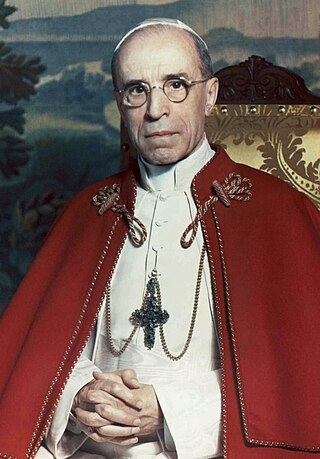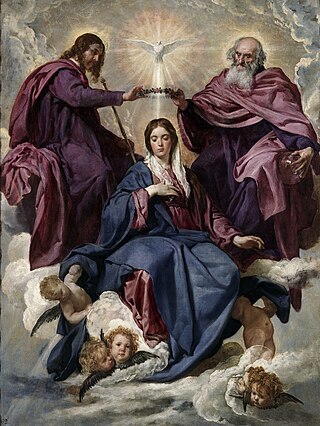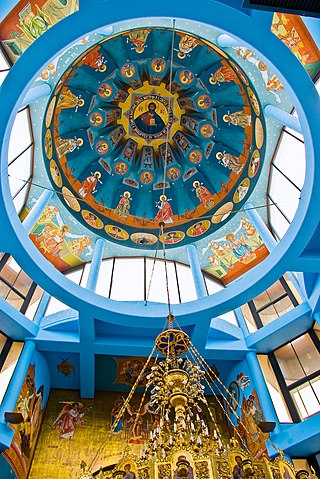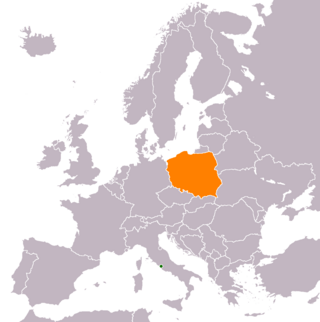
Pope Pius XII, born Eugenio Maria Giuseppe Giovanni Pacelli, was head of the Catholic Church and sovereign of the Vatican City State from 2 March 1939 until his death in October 1958. Before his election to the papacy, he served as secretary of the Department of Extraordinary Ecclesiastical Affairs, papal nuncio to Germany, and Cardinal Secretary of State, in which capacity he worked to conclude treaties with various European and Latin American nations, including the Reichskonkordat treaty with the German Reich.

Queen of Heaven is a title given to the Virgin Mary, by Christians mainly of the Catholic Church and, to a lesser extent, in Anglicanism, Lutheranism, and Eastern Orthodoxy. The title has long been a tradition, included in prayers and devotional literature and seen in Western art in the subject of the Coronation of the Virgin from the High Middle Ages, long before it was given a formal definition status by the Church.

Stanislaus of Szczepanów was Bishop of Kraków known chiefly for having been martyred by the Polish King Bolesław II the Generous. Stanislaus is venerated in the Roman Catholic Church as Saint Stanislaus the Martyr.

Prince Adam Stefan Stanisław Bonifacy Józef Cardinal Sapieha was a senior-ranking Polish prelate of the Catholic Church who served as Archbishop of Kraków from 1911 to 1951. Between 1922 and 1923, he was a senator of the Second Polish Republic. In 1946, Pope Pius XII created him a Cardinal.

Pietro Gasparri was a Roman Catholic cardinal, diplomat and politician in the Roman Curia and the signatory of the Lateran Pacts. He served also as Cardinal Secretary of State under Popes Benedict XV and Pope Pius XI.

Stefan Wyszyński was a Polish prelate of the Catholic Church. He served as Bishop of Lublin from 1946 to 1948, Archbishop of Warsaw and Archbishop of Gniezno from 1948 to 1981. He was created a cardinal on 12 January 1953 by Pope Pius XII. He assumed the title of Primate of Poland.

Wincenty Kadłubek was a Polish Catholic prelate and professed Cistercian who served as the Bishop of Kraków from 1208 until his resignation in 1218. His episcopal mission was to reform the diocesan priests to ensure their holiness and invigorate the faithful and cultivate greater participation in ecclesial affairs on their part. Wincenty was much more than just a bishop; he was a leading scholar in Poland from the twelfth and thirteenth centuries. He was also a lawyer, historian, church reformer, monk, magister, and the father of Polish culture and national identity.

The Diocese of Görlitz is a Latin Church diocese of the Catholic church in Germany. The current ordinary is Wolfgang Ipolt
Novimus Nos is an Apostolic Letter of Pope Pius XII to the Catholic Bishops of the Eastern Catholic Rites, whose dioceses are devastated after years of persecution. The letter commemorates the 1000th anniversary of the conversion of Saint Olga, which was the beginning of Christianity in Russia.
Gloriosam Reginam is a letter of Pope Pius XII to the Polish episcopate, to protest against the persecution of the Church in Poland, and, to commemorate the 300th anniversary of Jasna Góra, the Polish sanctuary of the Virgin Mary. The invincible Mother of God, who the pope says watches over the freedom for Poland, will most certainly assist.
Pope Pius XII and Russia describes relations of the Vatican with the Soviet Union, Russia, the Eastern Orthodox Church, and the Eastern Catholic Churches resulting in the eradication of the Church in most parts of the Soviet Union during the Stalinist era. Most persecutions of the Church occurred during the pontificate of Pope Pius XII.
Persecutions against the Catholic Church took place during the papacy of Pope Pius XII (1939–1958). Pius' reign coincided with World War II (1939–1945), followed by the commencement of the Cold War and the accelerating European decolonisation. During his papacy, the Catholic Church faced persecution under Fascist and Communist governments.
Pope Pius XII and Poland includes Church relations from 1939 to 1958. Pius XII became Pope on the eve of the Second World War. The invasion of predominantly Catholic Poland by Nazi Germany in 1939 ignited the conflict and was followed soon after by a Soviet invasion of the Eastern half of Poland, in accordance with an agreement reached between the dictators Joseph Stalin and Adolf Hitler. The Catholic Church in Poland was about to face decades of repression, both at Nazi and Communist hands. The Nazi persecution of the Catholic Church in Poland was followed by a Stalinist repression which was particularly intense through the years 1946–1956. Pope Pius XII's policies consisted in attempts to avoid World War II, extensive diplomatic activity on behalf of Poland and encouragement to the persecuted clergy and faithful.
Cum Jam Lustri is an apostolic letter of Pope Pius XII, dated September 1, 1951, to the bishops "and brave people" of Poland about their sufferings during Stalinist persecution. He asks for prayers to the Virgin Mary, because she will not deny her help to the Polish people, who dedicated themselves to her protection.
The liturgical reforms of Pope Pius XII took place mostly between 1947 and 1958.

The theology of Pope Pius XII is reflected in his forty-one encyclicals, as well as speeches and nearly 1000 messages, during his almost 20-year pontificate. The encyclicals Mystici corporis and Mediator Dei advanced the understanding of membership and participation in the Catholic Church. The encyclical Divino afflante Spiritu began opening the door to historical-critical biblical studies. But his magisterium was far larger and is difficult to summarize. In numerous speeches Catholic teaching is related to various aspects of life, education, medicine, politics, war and peace, the life of saints, Mary, the mother of God, things eternal and temporal.

The Mariology of the popes is the theological study of the influence that the popes have had on the development, formulation and transformation of the Roman Catholic Church's doctrines and devotions relating to the Blessed Virgin Mary.

Eastern Catholic victims of Soviet persecutions include bishops and others among the tens of thousands of victims of Soviet persecutions from 1918 to approximately 1980, under the state ideology of Marxist–Leninist atheism.

Holy See–Poland relations are foreign relations between the Holy See and the Republic of Poland. As of 2015, approximately 92.9 percent of Poles belong to the Catholic Church.












